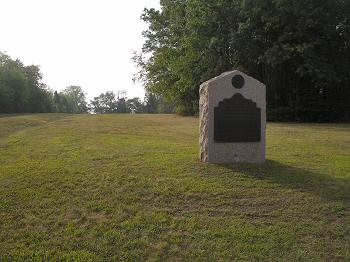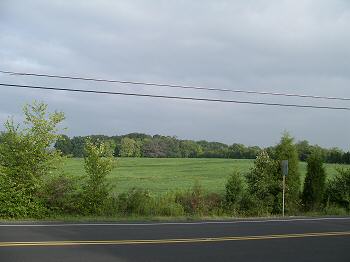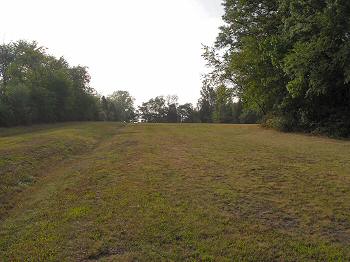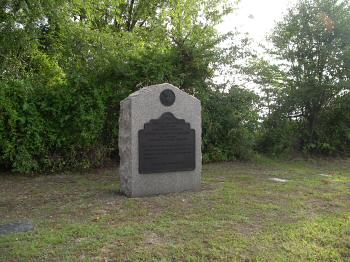|
South Cavalry Field is located on both
sides of Rt. 15 (the Emmitsburg Road) just south of its intersection with
Confederate Avenue.
On the morning of July 3, Union Cavalry Corps commander Maj. Gen. Alfred
Pleasonton ordered two of his brigades to the left flank of the Union
army. He ordered Brig. Gen. Wesley Merritt's Reserve Brigade of Buford's
division to move north from Emmitsburg to join Brig. Gen. Judson
Kilpatrick's division, moving from Two Taverns on the Baltimore Pike to
the area southwest of the Round Top mountain. By this time, the only
brigade in Kilpatrick's division was that of Brig. Gen. Elon J.
Farnsworth, George Custer's brigade having been detached for service with
David Gregg at East Cavalry Field. It is unclear what Pleasonton hoped to
accomplish. There is no record that he performed any reconnaissance in
this area. It has been speculated that Army of the Potomac commander
George G. Meade was preparing for a possible counterattack to follow the
repulse of Pickett's Charge, which he had anticipated since the night
before.
Farnsworth reached the area at approximately 1 p.m., about the time the
massive Confederate artillery barrage started in preparation for Pickett's
Charge, and his 1,925 troops took up a position in a line south of the
George Bushman farm. From left to right, the regiments were the 18th
Pennsylvania Cavalry, the 1st West Virginia, and 1st Vermont. Battery E.,
4th U.S. Artillery, occupied a small, rocky knoll in the rear and the 5th
New York cavalry was placed in a nearby ravine to guard the artillery.
Joined by Kilpatrick, they awaited Merritt's brigade, which arrived at
about 3 p.m. and took up a position straddling the Emmitsburg Road, to
Farnsworth's left. By this time the infantry portion of Pickett's Charge
had begun and Kilpatrick was eager to get his men into the fight.
On the Confederate line to the east of the Emmitsburg Road, only infantry
troops were involved. The four brigades of Hood's division, under the
command of Evander M. Law, had occupied the area from Round Top, through
Devil's Den, and back to the road since the battle on July 2. Initially
Law had just the 1st Texas Infantry (from Brig. Gen. Jerome B. Robertson's
Texas Brigade) facing Farnsworth to the south, but he soon reinforced them
with 47th Alabama Infantry, the 1st South Carolina, and artillery. To the
west of the road, facing Merritt, was the Georgia brigade of Brig. Gen.
George "Tige" Anderson.
Young Kilpatrick had little experience in commanding cavalry and he
demonstrated that by attacking fortified infantry positions in a piecemeal
fashion. West of the road, Merritt went in first, with his 6th
Pennsylvania cavalrymen fighting dismounted. Anderson's Georgians repulsed
their attack easily. Farnsworth was to follow, but he was astonished to
hear Kilpatrick's order for a mounted cavalry charge. The Confederate
defenders were positioned behind a stone fence with wooden fence rails
piled high above it, too high for horses to jump, which would require the
attackers to dismount under fire and dismantle the fence. The terrain
leading to it was broken, undulating ground, with large boulders, fences,
and woodlots, making it wholly unsuitable for a cavalry charge. Accounts
differ as to the details of the argument between Farnsworth and
Kilpatrick, but it is generally believed that Kilpatrick dared or shamed
Farnsworth into making the charge the latter knew would be suicidal.
Farnsworth allegedly said "General, if you order the charge I will lead
it, but you must take the awful responsibility."
First in the assault was the 1st West Virginia Cavalry, led by Colonel
Nathaniel P. Richmond. They rode in great confusion after coming under
heavy fire from the 1st Texas, but they were able to breach the wall.
Hand-to-hand fighting with sabers, rifles, and even rocks ensued, but the
attack was forced back. Of the 400 Federal cavalrymen in the attack, there
were 98 casualties. The second wave came from the 18th Pennsylvania,
supported by companies of the 5th New York, but they were also turned back
under heavy rifle fire, with 20 casualties.
It was finally the turn of the 1st Vermont Cavalry, about 400 officers and
men, which Farnsworth divided into three battalions of four companies each
under Lieutenant Colonel Addison W. Preston, Major William Wells, and
Captain Henry C. Parsons. Parsons's battalion led the charge, passing the
Texans and riding north into the blinding sun toward the John Slyder farm.
Evander Law sent three Georgia regiments (the 9th, 11th, and 59th) to move
to the support of the Texans and the artillery batteries. A staff officer
carrying the order encountered the 4th Alabama, who also joined in
support. An Alabama lieutenant yelled "Cavalry, boys, cavalry! This is no
fight, only a frolic, give it to them!" And the infantrymen eagerly found
many easy targets.
All three battalion advances were turned back with great losses. The final
group, led by Wells and by Farnsworth himself, circled back toward Big
Round Top, where they met a line of the 15th Alabama across their front.
Farnsworth's party had dwindled to only 10 troopers as they weaved back
and forth, trying to avoid the murderous fire. Farnsworth fell from his
horse, struck in the chest, abdomen, and leg by five bullets. Postwar
accounts by a Confederate soldier that claimed Farnsworth committed
suicide with his pistol to avoid capture have been discounted. Major Wells
received the Medal of Honor for his heroism in leading the rest of his men
back to safety. The Vermont regiment suffered 65 casualties during the
futile assault.
Kilpatrick's ill-considered and poorly executed cavalry charges are
remembered as a low point in the history of the U.S. Cavalry and marked
the final significant hostilities at the Battle of Gettysburg. Six miles
west of Gettysburg, one of Merritt's regiments, the 6th U.S. Cavalry, was
defeated that afternoon at Fairfield by Brig. Gen. William E. "Grumble"
Jones's "Laurel Brigade," an action not considered to be a formal part of
the Battle of Gettysburg.
All of Pleasonton's cavalry brigades would be exercised for the remainder
of the Gettysburg Campaign in the lackluster pursuit of Lee's army back
across the Potomac. |




